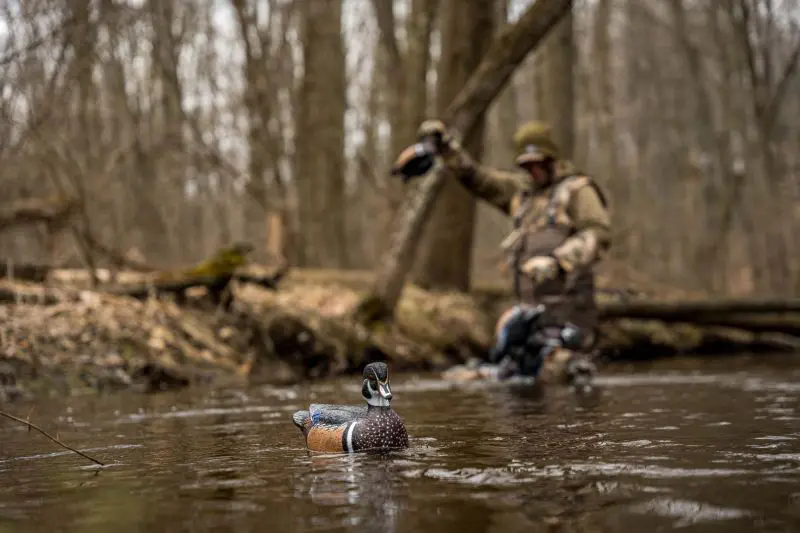A modest and strategic hunting plan to whet your waterfowl whistle
Ask an ex-waterfowler why they bagged (pun intended) the sport, and a likely response is that it got to be too much work, especially for hunters longer in the tooth. With all the decoy upkeep and untangling, deployment and retrieval in the cold and dark, perpetual boat and trailer maintenance, and that two-bit lazy dog that hasn’t seen a dummy in months – well, that last one is on you…dummy. Anyway, you can sort of understand why folks retire from waterfowling.
We of course know those fellas miss anxiously watching-their-watch while shapeless shadows buzz overhead in the blackness, not to mention that fireworks show aroma of a freshly emptied chamber. But what if there was a simple way to stay in the game and still get that duck hunting high?
Let’s call this minimalist approach, “duck hunting light”. It necessitates a condensed and controllable mindset to both hunting strategy and the gear involved. With the proper plan, you can hunt small and successfully, even before or after work or school. And it begins with site selection.
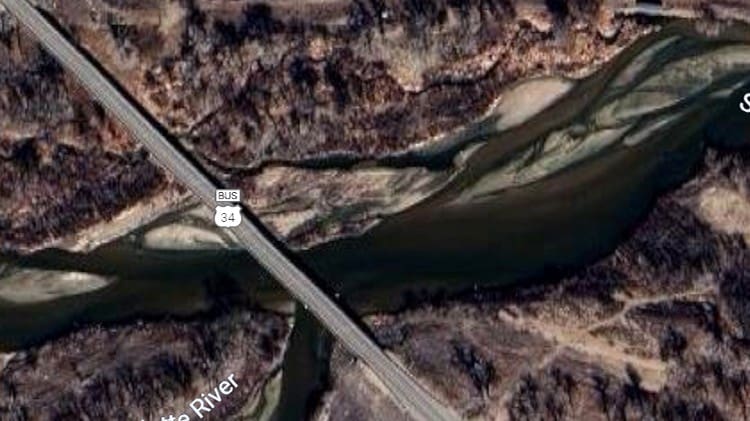
Riverine Environments
Access is everything. In fact, statistics indicate that one of the top contributing factors to the decline in waterfowlers is having limited or no access to property. And what about those few public places? They get pounded, while every landowner’s door has been knocked into splinters, leaving you in the cold.
Moving water to the rescue. Open Google Maps and identify the rivers and streams inside 30-minutes of your home and outside city limits. Next, go to the satellite setting and take note of uninhabited stretches– the green and brown stuff without buildings. Then, switch over to your onX Hunt smartphone app – a must for the minimalist hunter. onX offers the most accurate and current landownership data.
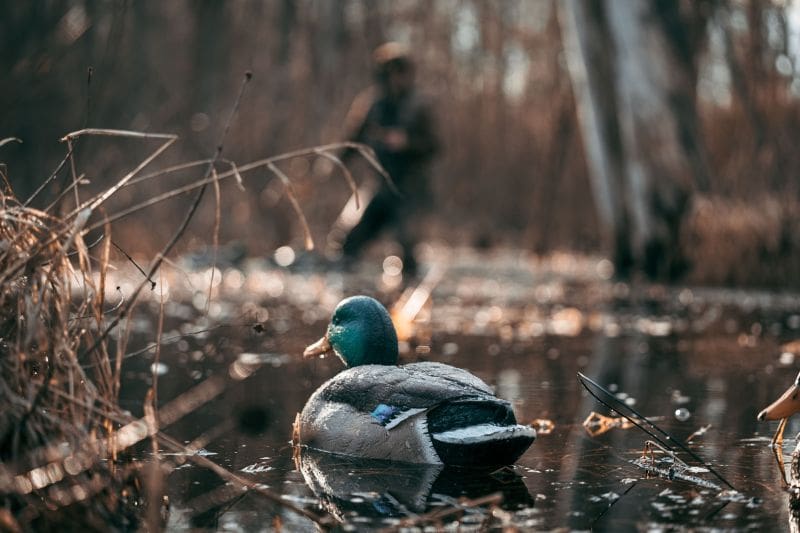
Between the mapping, researching, and your personal knowledge of public places, you should be able to select a river or stream with instant to reasonably swift access for blitzkrieg hunts. Oftentimes, you can hunt within minutes of your vehicle, be it parked on a gravel road, at a boat landing, or even a park nearby a huntable stretch of water.
Walkable banks are another upside of most riverine environments. You’re more likely to have to break some brush than trudge through gumbo muck. And, if it is muddy, keep in mind the human-duck-retrieval factor. Can you get to a fallen bird? More on that in a minute…
Specific site selection is important, too – no different than refining a spot on bigger water. Points are profitable. Look for nice big river swings and bends that apex into a tangible point, even better if the river narrows off the tip. That’s how you cut ducks off at the pass.

Concealment is typically a cinch, too. Nature provides its own build-a-blind workshop. A few hearty broken branches in an A-frame superstructure woven with whatever ground cover is available and you’re golden. Combine the freshly constructed flora blind with a Hardcore camouflage uniform and you’re virtually invisible.
Scouting
I don’t, however, advise pulling up on a virgin hunting spot based solely on digital research. You need boots on the ground, too, and without a shotgun in hand. Walk the bank and find the perfect shooting position with the best access. Eyeball the fixings for building that blind, too. Heck, go ahead and assemble it in advance so it’s ready to rock if you’re gunning at sunrise.
Hunker down a while, too. Take it all in. Watch how birds zip through. Are they winging upstream or downstream? Low or high? Nearer your bank or across the water? It’s all prized information to feed the mental computer. You might find locational adjustments are necessary to effectively intercept birds. Maybe it’s a poor stretch in general and a wholesale recalculation is in order. Or, hopefully, it’s perfect.
But perhaps the most important aspect of scouting is determining where the ducks are coming from and going. To that, it’s advisable to scout a day or two before the hunt and sit the spot until sundown-ish. This provides the best intel for what direction the birds are overnighting or feeding as you track their flightpaths, whether they’re burning along the surface or crisscrossing overhead. Then, before darkness, and with that directional data in mind, jump in the truck and see about finding that roost or field. Could be a nearby lake or marsh. Might even be a bay or wetland attached to the same river. All valuable information for selecting that cherry spot.
Think about your days scouting and hunting like LEGOS. Each outing produces another block of information about the area’s waterfowl innerworkings, like seasonal flight path changes, rotation of available species, times of peak activity, etc.
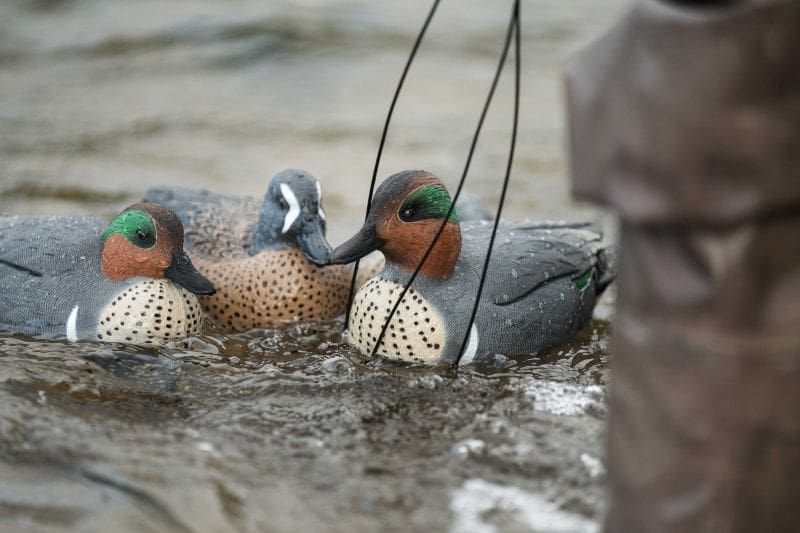
Ducks and Decoys
The minimalist mindset applies to decoys as well. A half dozen birds in a bag and you’re good to go. The goal isn’t trying to get a full-blown flock to lock wings and land, but rather influencing those scratch doubles and triples to swing in your direction or at least throttle back from light speed flight. Occasionally, however, a loner or pair will commit to land. And don’t be surprised to see a single paddling upstream to join your fake family of fowl.
Besides positioning the half dozen dekes for attraction and optimal shooting, you must also consider depth. This hip-boot and wader country. DO NOT float decoys deeper than you’re willing to wade. Same goes for shooting. It doesn’t do any good to fold a bird in unretrievable water. That’s a demerit and should be counted toward your daily bag.
To that, consider the current. It’s a waste to drop a bird downstream if you can’t get to it. That’s a five-minute major in the duck hunting penalty box.
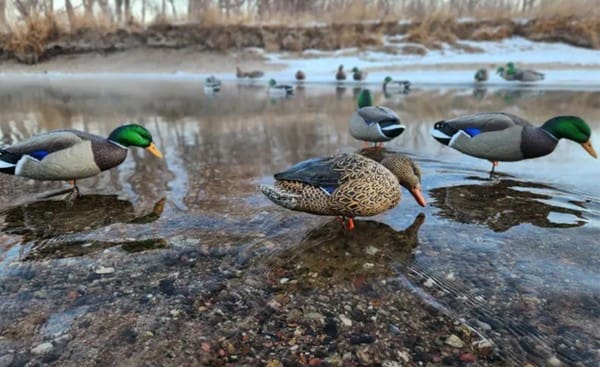
Current must also be considered when anchoring the decoys. Think 6-ounce or heavier if there’s any degree of current. Keep the cords short, too, just enough to anchor the decoy and hold the cord at a 45-degree angle between the weight and bird. Extra line causes floaters to zig, zag, and ultimately collide and tangle with the other decoys.
Subjectively scatter the decoys per usual, giving it a loose lollygagging feel with generous space between singles and doubles. If the shoreline offers swaths of sand or gravel, drop a bird or two at water’s edge, keels pressed into the substrate.
Match those select six decoys to the season and predominant species at hand. Think a half dozen mallard floaters for all-round applications; 6 teal or wood ducks for early season; and some divers for the end of season. And, with such a modest number of decoys necessitated for the minimalist approach, you can splurge a bit on quality.

Parting Words
This is be-on-your-toes hunting. Birds will seemingly materialize out of thin air, so keep your head on a swivel. The shootable range might be tight, too, yielding only seconds to unload. Throw in the fact that it’s a short window time-wise, and you better be glued to that shotgun. Put the phone away. Eyes to the skies.
Riverine environments are especially important to northern waterfowlers that hunt till season’s end. Likely, the ponds and smaller lakes are glazed over. Probably some shoreline ice on the big lakes, too. But those rivers? There’ll still be water pumping somewhere. And any ducks procrastinating migration will be around.

